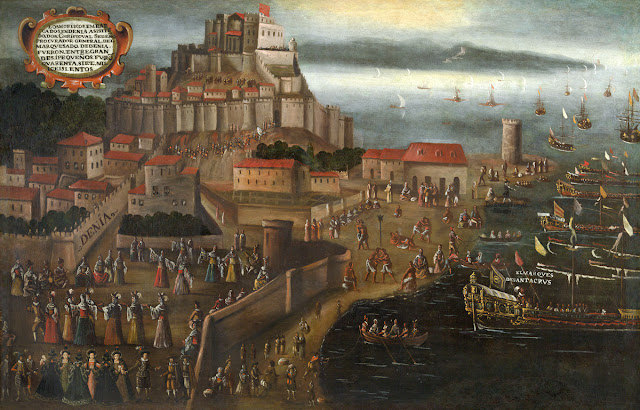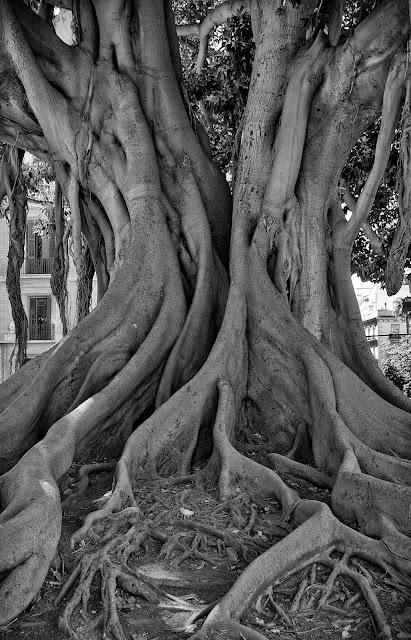Wednesday, February 6, 2019 – I would like to begin by
apologizing to readers of delicate sensibilities, be there any, for one of the
photos in my last post. It’s a shot of a gargoyle on La Lonja de Seda, the old
silk exchange in the centre of Valencia. I had not noticed initially, but it’s quite
lewd. Here, I’ll post it again so you can see what I mean. Click on the
picture to enlarge it.
It shows a winged figure, possibly a fallen angel,
holding his, um, equipment in one hand and a cup in the other, into which he
appears to be peeing. But the cup is tilted down, so any pee would spill out,
onto the heads of passersby below. The devil! In any case, my apologies.
Looking at the picture more closely also persuades me
that this is, after all, a real gargoyle in the sense of being part of a
rainwater drainage system.
The warmth has returned to Valencia. The sirroco or
mistral, or whatever they call the persistent onshore wind here, died over
Sunday night. Monday dawned sunny, bright and still, if cold. When I went out for
a run about 10 it was supposedly still only 8C. It felt warmer in the
sun, though. I ran through Ruzafa to Regne de Valencia, down to the river, along it to
Marqués de Túria and back up the Gran Via to Ruzafa – not quite 5K.
Later in the morning, we walked down to take a look at
the last of the art shows at Bancaja, the bank cultural foundation. The first exhibit was more of historical than artistic interest. It’s a display of 17th century paintings depicting the 1609 expulsion of the Moriscos, the
descendants of Spain’s Muslim population that remained after the final reconquest of the peninsula by Christian forces in 1491. Authorities expelled an
astonishing one third of the country’s population. Valencia was one of the
departure points.
 |
| Expulsion of the Moriscos at the port of Dénia, Vincente Mostre |
The paintings, which are visually not terrifically
interesting, were commissioned by Philip III, the king who ordered the
expulsions. They’re propaganda in other words, but so is the show. It’s meant
to remind modern Spaniards of this dark deed from their past, which has obvious
parallels with today’s Islamophobia and the calls for tighter immigration controls.
Dissatisfied with this show, we went around to the
other side of the building and had a look at the only other we
haven’t seen. It’s an exhibit of paintings by Uiso Alemany (1941-), a
Valencian-born artist. The show was entitled “The Suicide of Painting.” The
brochure did have an English translation, but it was so bad, and/or the
curatorial thinking, or the artist’s intentions, were so woolly-headed
that we gave up trying to figure out what it was supposed to be about.
 |
| Uiso Alemany |
“I’d say he caused
the suicide of painting,” was Karen’s comment after looking at the works on
display. She didn't like them.
One of the pieces is an installation the artist
created especially for this show. It’s a very expressionistic, primitivist
depiction of sheep and herders painted on some kid of shiny silver plastic,
parts of which are left unpainted so you can see your own reflection beside the
painted figures. The installation, according to the English translation in the
brochure “...is a critical allegory of the circle of art: a complete sheeple
one. Uiso Allemany places the viewer in a sheeple scene, assuming that the
mirror can give us what we do not desire.”
 |
| Uiso Alemany: "a sheeple scene" |
My first thought was that this was the output from
some machine translation system. But no, it takes a special, human kind of
incompetence with the language to come up with “sheeple.” To be fair, the words
in the original Spanish are not easy, and may, given the level of language
skills among most art curators, have been misused, or at least used oddly. The first
instance, “a sheeple one,” is a translation of “aborregamiento.” According to SpanishDict.com, it’s a noun from the verb “aborregarse,” meaning “to
follow like a sheep...” or “tag along,” which seems to fit. SpanishDict also
says it can mean “to cloud over” or “to be silly” or “get silly.” Okay. In the second
instance, “a sheeple scene,” is a translation of, “una escena borreguil.” Same etymology. SpanishDict translates “borreguil” as “sheeplike” or “meek, like a lamb.”
It boils down to: the piece is an
allegory critical of the sheep-like nature of the art world. Or perhaps, the
woolly-headedness of the art world? Ironic. But who is the ironist?
All this being said, I didn't hate the work. It was vibrant and colourful, to say the least. Most of the paintings were done on canvas that had been stiffened and "rumpled" into waves to give the work a three-dimensional effect.
 |
| Uiso Alemany |
After Bancaja, we wandered over to Glorieta Park
across the street. Karen sat in the sun on a bench while I took pictures of the giant fig trees. I have been trying for years to capture these
trees, which you find all across southern Europe. I've never had much success. They’re
massive and the older and bigger they get, the more bizarrely shaped and
Elephant-mannish they get. I came a little closer to what I wanted this
time.
Home for lunch. I can’t remember if we went out again. I
think we went for a walk in Ruzafa later in the afternoon.
Tuesday was forecast to be 21C and sunny. We decided
to go out for lunch, then ride to the beach. We set out about 1:30, thinking
we’d find a place for lunch around the neighbourhood. We couldn’t find anything
we liked the look of. So we wandered over into Exeimple, the posh area between Avenida de Colón and Gran Via de Marqués de Túria.
It’s funny, when you’re not looking for a lunch place,
you see all kinds. When you’re starving, you can’t find anything. We walked
down to the Colón market, which is filled with eating and drinking places.
Nothing looked right. So we kept going, across Avenida de Colón, into the edge
of Carmén. It was almost 2:30 by the time we finally settled on a place on the
pedestrian-only Carrer de Navellos –the street with the Borgia palace. We sat outside, but there was no sun.
We
once had an awful meal on this street, one of the worst we’d ever had in
Valencia. The place we chose this time clearly wasn’t that
place. It was quite good, if unfancy. The menu
del dia was 8.90€ and included three courses, bread and drink. I had Cuban
rice for starters, which turned out to be nothing like the rice I’d had in
little Havana in Miami years ago. This was a pile of Valencian rice served on a
plate with a puddle of bottled tomato sauce for dipping, and a mild chorizo
sausage. There was a fried egg on top. Very filling. Karen had the ubiquitous mixed
salad with tuna and hard boiled egg. For mains, Karen had chicken in mushroom
sauce, and I had pork loin fillets with fried peppers and fries. Dessert: ice cream
for Karen, a baked apple for me. We left satisfied.
We walked back the way we’d come towards the river –
taking pictures of the pretty streetscapes along the way.
We picked up bikes across from the river and rode
through the centre and out across the river. It was a route that started out
familiar – past the University of Valencia and the football stadium – and then,
after a wrong turn (or maybe a non-turn), became less familiar. It did get us
eventually to Cabanyal and then over to the beach, but it wasn't the route we thought we were on that goes out past the suburban Polytechnic University. Cabanyal was dead as usual,
it being siesta time. We zig-zagged through streets with lots of street art. Must
go back and find them again when we’re on foot.
 |
| On the beach |
 |
| On the tram home |
 |
| Late sun on the former insurance building across from Estación de Norte |









No comments:
Post a Comment